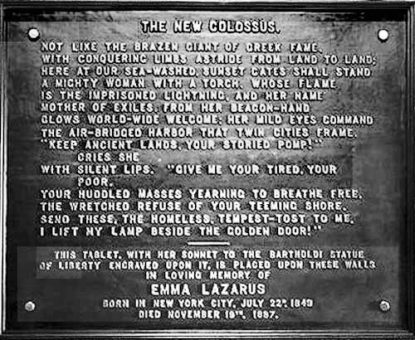Colossus: Investigating a Poem

We all read this poem in school, but I realized this weekend that I really didn’t know much about it. So I looked it up.
Emma Lazarus wrote it in 1883 as part of a fundraiser for a pedestal to hold “La Liberté éclairant le monde” – the full name, of course, of the statue France presented the United States after the Civil War. (And which, BTW, America didn’t super love. Poor Lady Liberty was a bit of a white elephant. The New York Times’ opinion was: “no true patriot can countenance… expenditures for bronze females in the present state of our finances.” Meow.)
In any case, Emma’s sonnet wasn’t published until 1903. (This was, by the way, the same year the U.S. passed the Anarchist Exclusion Act, which, among other things, banned the immigration of people with epilepsy. Wow.)
The overall view of immigrants was not rosy. Most immigrants were no longer Protestant Northern Europeans, but mostly poor, unskilled Catholics and Jews, coming from Southern and Eastern Europe to escape poverty and persecution. (Emma was Jewish, and her family, several generations back, had been from Germany and Portugal.)
Emma’s sonnet contrasted the new statue with the mythic Colossus of Rhodes. While also “mighty,” Emma imagined that Lady Liberty, unlike Rhodes’ hero, cared not for power but sought only to save the helpless.
But at the time many Americans didn’t have a lot of time for that sentiment. There was a recession underway and they were worried enough about their own selves. They didn’t want to deal with these poor folks coming over being the wrong races and having the wrong religions.
Plus ça change, eh, Liberté?
Be the first to leave a comment.